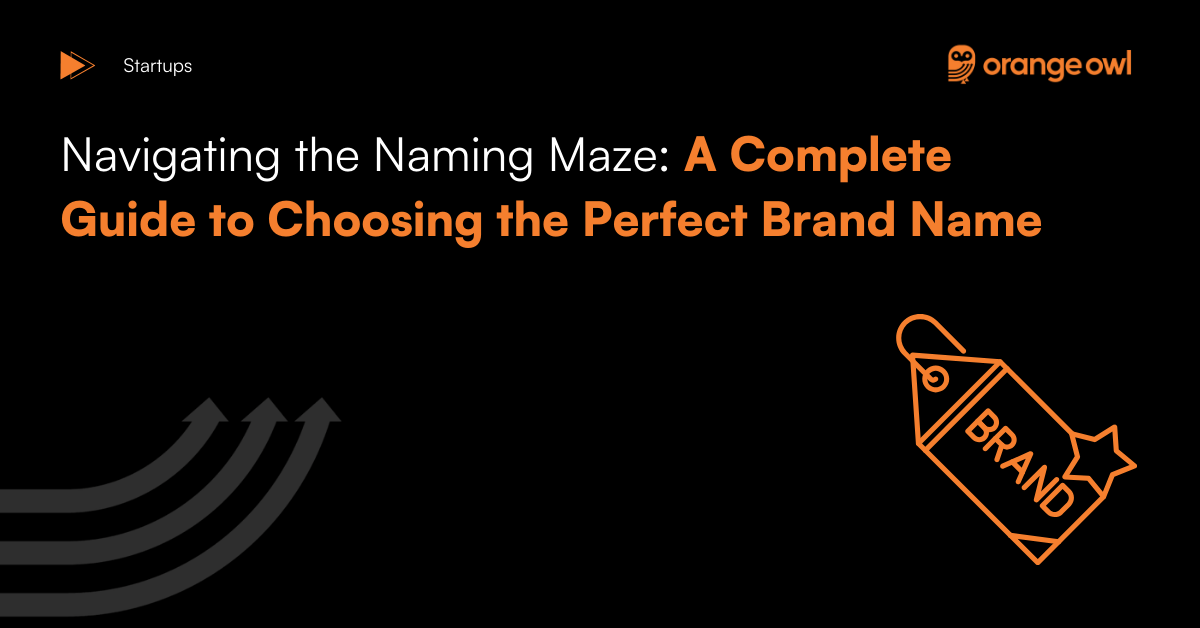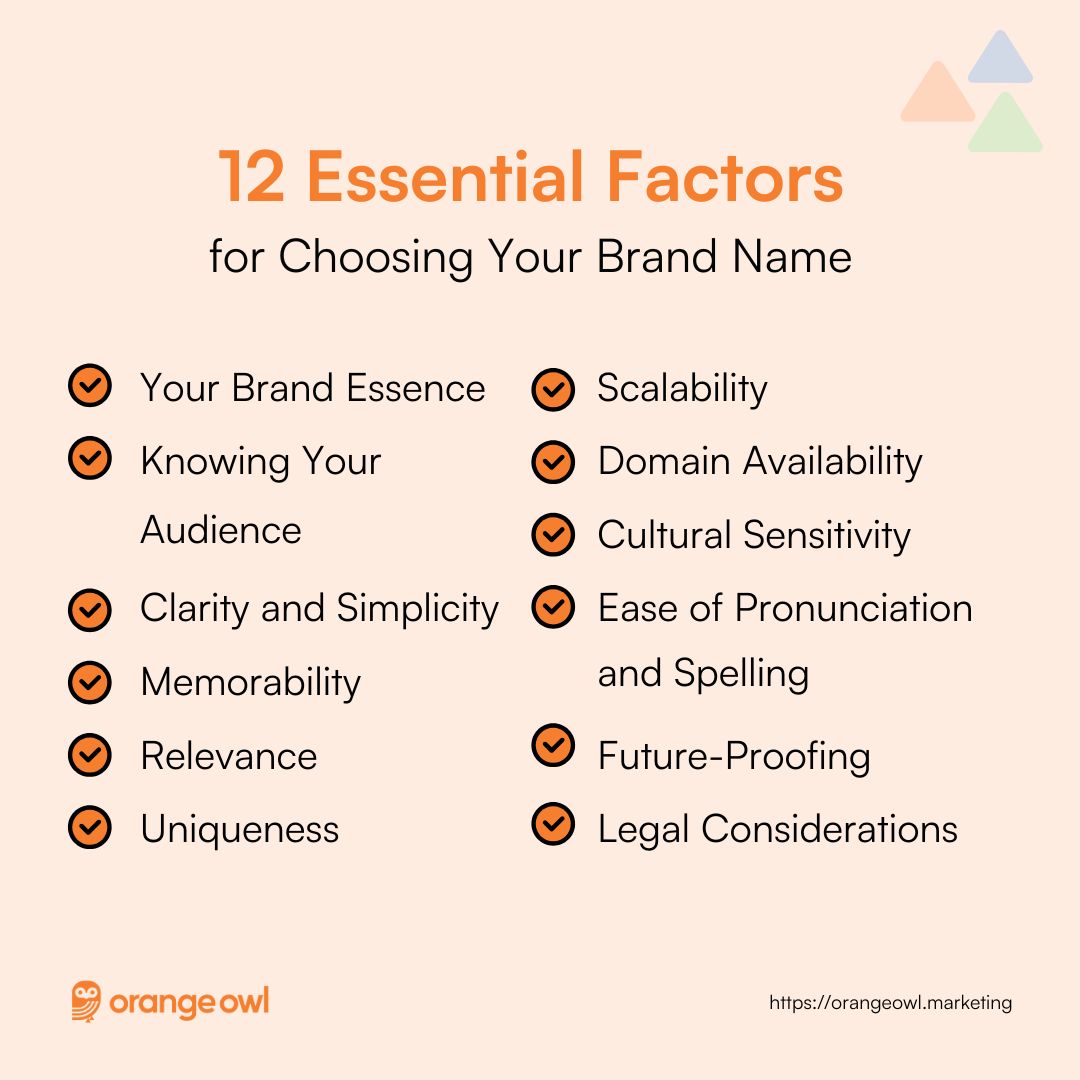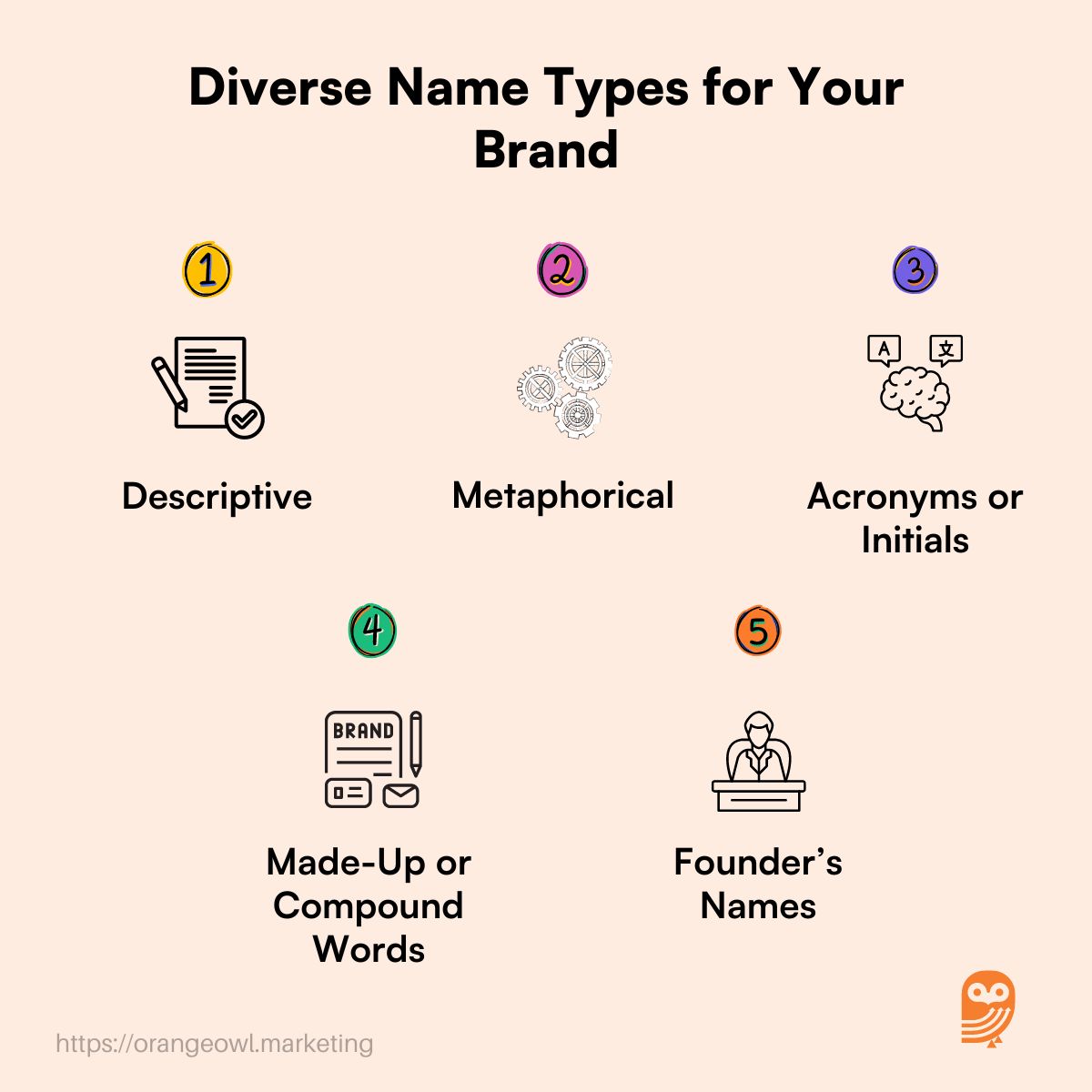Navigating the Naming Maze: A Complete Guide to Choosing the Perfect Brand Name
Vivek Goel
February 9, 2025

Table of Contents
Coming up with the right name for your brand, whether it’s a company, product, or service, is no small feat. It’s a critical step in establishing your brand identity and making a lasting impression on your audience. However, the process can be challenging, as it involves considerations such as clarity, memorability, relevance, and more.
This blog provides a comprehensive guide on how to navigate this naming maze and arrive at the perfect name for your venture.
Top 12 Things to Consider When Choosing the Perfect Brand Name

1. Your Brand Essence
Your brand essence is the core of your brand — the heart and soul that sets you apart from the competition. It encapsulates your brand’s values, mission, and the emotional response you want to elicit from your audience.
Before diving into naming, spend time clearly defining your brand essence. This clarity will guide you in selecting a name that aligns with your brand’s personality.
Expert Tip: Use a brand essence wheel to articulate the key elements that define your brand, such as tone, attributes, and emotional benefits. This visual tool can serve as a reference point when brainstorming names.
Example: If your brand essence revolves around innovation, reliability, and a sense of adventure, a name like “InnoQuest” might capture these values.
As another example, consider a marketing agency that was founded with a deep passion for the industry. The brand’s essence was rooted in creativity, wisdom, and a commitment to delivering insightful and impactful solutions. To reflect this, the founders chose the name “Orange Owl”—where “Orange” symbolizes the vibrant energy and creativity driving their work, and “Owl” represents the wisdom and industry knowledge they bring to their clients. The name perfectly encapsulates the agency’s mission and values, serving as a strong foundation for its brand identity.
2. Knowing Your Audience
Understanding your target audience is crucial when selecting a brand name. Their preferences, language, cultural nuances, and even lifestyle choices can influence how they perceive your brand. Conduct market research and gather insights about your potential customers. Your brand name should resonate with them and speak to their needs or desires.
Expert Tip: Create detailed buyer personas to get a clearer picture of your audience’s demographics, interests, and pain points. This will help you tailor a name that appeals directly to your target market.
Example: For a brand targeting environmentally conscious consumers, understanding their preference for sustainability could lead to names like “EcoHarbor” or “GreenVibe.”
3. Clarity and Simplicity
A clear and simple name helps customers easily understand what your business is about. It should be straightforward, avoiding unnecessary complexity, to ensure accessibility. A simple name is easier to remember, pronounce, and spell, making it more likely to stick in the minds of consumers.
Expert Tip: Test the clarity of your brand name by asking a diverse group of people to pronounce it and guess what your business does. Their feedback will help you gauge whether the name is intuitive and aligned with your brand’s offerings.
Examples: “Apple” (clear and simple, associated with technology) and “Nike” (simple, easy to remember, and related to victory).
4. Memorability
A memorable name aids brand recall. It sticks in the minds of customers, making it more likely they’ll remember your business when making purchasing decisions. A memorable name often has a rhythmic quality, distinctive sound, or visual imagery that makes it stand out.
Expert Tip: Use alliteration, rhyme, or a unique combination of letters to enhance the memorability of your brand name. However, ensure it remains easy to spell and pronounce.
Examples: “Google” (distinctive and memorable) and “Coca-Cola” (memorable, even with a playful twist).
5. Relevance
The name should relate to your product or service, providing customers with an immediate understanding of what you offer. A relevant name acts as a descriptive shorthand, helping consumers quickly grasp your brand’s purpose or value proposition.
Expert Tip: Align your brand name with your core offering or the problem you’re solving for customers. This relevance can strengthen brand recognition and loyalty.
Examples: “Pizza Hut” (clearly indicates the type of food) and “Snapchat” (reflects the ephemeral nature of the content).
6. Uniqueness
Ensure your name is distinctive to avoid confusion with competitors. It should be original and not infringe on existing trademarks. A unique name differentiates your brand in a crowded marketplace and helps build a strong, recognizable identity.
Expert Tip: Conduct a thorough competitor analysis to identify naming trends and gaps in the market. Aim for a name that stands out but still feels relevant to your industry.
Examples: “Amazon” (unique and not directly associated with a specific product) and “Starbucks” (distinctive and not easily confused with other brands).
7. Scalability
Choose a name that can grow with your business. It should remain relevant even as your offerings or market reach expands. A scalable name is flexible enough to encompass future product lines, services, or geographic expansions without feeling outdated or limiting.
Expert Tip: Avoid overly specific names that might box you into a particular niche or market. Think long-term and consider how your brand name will adapt to potential changes or growth.
Examples: “General Electric” (scalable across various industries) and “Microsoft” (began with a focus on microcomputers but expanded over time).
8. Domain Availability
In today’s digital age, having a matching domain name is essential for consistency in your online presence. Check if the domain name is available before finalizing your brand name. Securing a domain that matches your brand name strengthens your brand’s credibility and makes it easier for customers to find you online.
Expert Tip: If your preferred domain is taken, consider creative alternatives like adding a keyword related to your industry or using a different top-level domain (TLD) such as .co, .net, or .io.
Examples: “Airbnb.com” (matching the company name) and “Uber.com” (aligned with the brand).
9. Cultural Sensitivity
Be aware of cultural connotations and potential translations to avoid unintended negative associations. A name that works well in one region might have an entirely different, possibly offensive, meaning in another. This is especially important if you plan to expand internationally.
Expert Tip: Conduct linguistic and cultural research in all the markets you plan to enter. Consider hiring a cultural consultant to assess the potential implications of your brand name.
Examples: “Nova” (a car model that means “no go” in Spanish, not considering cultural nuances) and “Penneys” (had to be changed to “Primark” in some countries due to cultural associations).
10. Ease of Pronunciation and Spelling
A name that is easy to pronounce and spell aids word-of-mouth marketing and online discoverability. If your name is difficult to say or spell, potential customers might struggle to remember it or find you online, reducing your brand’s visibility.
Expert Tip: Aim for a name that passes the “radio test” — it should be easily understood and spelled correctly when spoken aloud.
Examples: “Visa” (simple and universally pronounceable) and “Häagen-Dazs” (though not simple, it has a distinct pronunciation that contributes to its premium brand image).
11. Future-Proofing
Anticipate future trends to ensure your name remains relevant and doesn’t become outdated. The business landscape is constantly evolving, and a name that feels modern today might feel dated in a few years. Future-proofing your brand name involves considering how technological, cultural, or industry trends might impact your brand in the long run.
Expert Tip: Regularly revisit your brand name as part of your brand strategy review. Ensure it continues to align with your business’s direction and market trends.
Examples: “IBM” (originally International Business Machines, but evolved with the industry) and “Netflix” (adapted from DVDs to streaming).
12. Legal Considerations
Consult legal professionals to avoid trademark or copyright issues, which can lead to costly legal battles. Ensure that your brand name is not already trademarked or too similar to existing brands. Trademark infringement can lead to legal disputes and require a costly rebranding effort.
Expert Tip: Perform a trademark search early in the naming process. Consider registering your trademark to protect your brand identity from competitors.
Examples: “Lumia” (Microsoft had to drop this name due to a trademark dispute) and “iPhone” (successfully trademarked by Apple).
Diverse Name Types for Your Brand
Names come in all shapes and sizes. Some tell you exactly what a business does, like “Burger King,” while others use symbols or founder names, like “Apple.” Some are made from initials, like “IBM,” and others blend words together, like “Microsoft.” There are many ways to go about it, so let’s explore a few to help you find what feels right for your brand.

1. Descriptive Names
Descriptive names directly convey what the business or product does. They provide immediate clarity and are often easier to market because their meaning is obvious.
Expert Tip: While descriptive names are clear, they can also be limiting if you plan to expand your offerings. Ensure that your name allows for some flexibility.
Examples: “American Airlines” (clearly indicates the industry and location), “The Home Depot” (describes the retail focus), “Burger King” (highlights the main product), “General Motors” (indicates a broad range of vehicles).
2. Metaphorical Names
Metaphorical names use symbols or concepts to represent the brand without directly describing the product or service. These names often evoke a certain image or feeling, allowing for deeper brand storytelling.
Expert Tip: When choosing a metaphorical name, ensure it aligns with your brand essence and resonates with your target audience. The name should evoke positive associations.
Examples: “Apple” (metaphor for something simple, yet innovative), “Adobe” (suggesting creative elements), “Oracle” (implying wisdom and foresight), “Amazon” (symbolizes vastness and variety).
3. Acronyms or Initials
Acronyms and initials simplify longer business names, making them easier to remember. They are often used by large corporations with long, descriptive names that would be cumbersome to use in everyday branding.
Expert Tip: If using an acronym or initials, ensure that the full name still resonates with your brand essence and that the acronym itself is memorable.
Examples: “IBM” (International Business Machines), “GE” (General Electric), “BMW” (Bayerische Motoren Werke), “KFC” (Kentucky Fried Chicken).
4. Made-Up or Compound Words
Made-up names or compound words combine elements of existing words to create something entirely new and unique. These names can be highly distinctive and memorable, offering strong brand differentiation.
Expert Tip: When inventing a name, consider the linguistic and phonetic qualities. The name should be easy to pronounce and spell while still being distinctive.
Examples: “Microsoft” (Microcomputer + Software), “FedEx” (Federal Express), “Pinterest” (Pin + Interest), “Spotify” (Spot + Identify).
5. Founder’s Names
Using the founder’s name gives the brand a personal touch, often adding a sense of legacy and trustworthiness. However, this approach may not be as descriptive or memorable unless the founder is already a well-known figure.
Expert Tip: Consider how the founder’s name fits within the broader brand narrative. If the name is difficult to pronounce or spell, it might create challenges for brand recognition.
Examples: “Ford” (Henry Ford), “McDonald’s” (Richard and Maurice McDonald), “Disney” (Walt Disney), “Tesla” (named after Nikola Tesla).
Steps to Come Up with the Perfect Brand Name
Creating a brand name is both an art and a science. It involves balancing creativity with strategic thinking to ensure the name resonates with your audience and represents your brand’s essence. Here’s a step-by-step guide to help you come up with the perfect brand name:
1. Define Your Brand Identity
- Start Here: Clearly articulate your brand’s mission, values, and personality. What emotions do you want your brand to evoke? What message do you want to convey?
- Why It Matters: Your brand name should align with and reflect your brand identity.
- Example: If your brand identity is centered around innovation and cutting-edge technology, your name should reflect that, like “Tesla” or “InnovateX.”
2. Conduct Market Research
- Start Here: Understand your target audience and competitors. What names resonate with your audience? What names are your competitors using?
- Why It Matters: This research will help you identify gaps in the market and ensure your name stands out.
- Example: If your competitors are using very formal, corporate names, a more casual, approachable name might help you differentiate your brand.
3. Brainstorm and Ideate
- Start Here: Gather a diverse team and conduct brainstorming sessions. Encourage creative thinking and explore different name types (descriptive, metaphorical, acronyms, etc.).
- Why It Matters: A collaborative approach often leads to more diverse and innovative name ideas.
- Example: Companies like “Pinterest” and “FedEx” were born out of brainstorming sessions that combined words to create something new and memorable.
4. Create a Shortlist
- Start Here: Narrow down your list of potential names to a handful of top choices. Focus on names that are memorable, relevant, and align with your brand’s identity.
- Why It Matters: This step allows you to focus on the best options and prepare for deeper analysis and testing.
- Example: From a list of 20 potential names, narrow down to 3-5 that best represent your brand and have strong potential.
5. Check for Availability
- Start Here: Conduct a trademark search and check domain name availability for your shortlisted names. Ensure the names aren’t already in use or legally protected.
- Why It Matters: This step prevents potential legal issues and ensures you can secure a matching domain name.
- Example: If you find your top choice is already trademarked or the domain is taken, move on to your next best option.
6. Test Your Name
- Start Here: Test your name with a focus group or through surveys. Gather feedback on pronunciation, spelling, and overall impression.
- Why It Matters: This step ensures that your audience connects with the name and finds it easy to remember and pronounce.
- Example: Test how well your name resonates with different demographics and ensure it aligns with your target audience’s preferences.
7. Finalize and Register
- Start Here: Once you’ve selected the final name, register the trademark and secure the domain. Ensure all legal protections are in place.
- Why It Matters: Securing your brand name legally ensures that you can build your brand without fear of infringement or rebranding.
- Example: After finalizing “Amazon,” Jeff Bezos secured the domain and trademark, paving the way for the brand’s global expansion.
Common Pitfalls in Choosing a Brand Name
Even with careful planning, there are common pitfalls that can derail the naming process. Here’s what to watch out for and how to avoid these mistakes:
1. Being Too Literal or Descriptive
- Pitfall: A name that’s too descriptive can limit your brand’s future growth or pigeonhole you into a specific niche.
- How to Avoid: Choose a name that’s relevant but not overly specific, allowing room for brand expansion.
- Example: A name like “JustBooks” might limit a company that later wants to expand into other forms of media.
2. Ignoring Audience Perception
- Pitfall: Failing to consider how your name will be perceived by your target audience can lead to misunderstandings or a lack of connection.
- How to Avoid: Conduct audience testing to ensure your name resonates with your intended demographic and evokes the right emotions.
- Example: The brand “Nova” failed in Spanish-speaking markets because “no va” means “no go” in Spanish—a costly oversight.
3. Overcomplicating the Name
- Pitfall: A name that’s difficult to spell, pronounce, or remember can hinder word-of-mouth marketing and make it harder for customers to find you online.
- How to Avoid: Keep it simple and test your name’s clarity by saying it aloud to others.
- Example: Complex names with unusual spellings may be memorable, but they can also confuse potential customers, making them harder to remember and search for online.
4. Focusing Too Much on Trends
- Pitfall: Choosing a name based on current trends can make your brand feel outdated as trends change.
- How to Avoid: Opt for a timeless name that won’t lose relevance as the market evolves.
- Example: Names that include trendy buzzwords or phrases might feel fresh today but could quickly become dated (e.g., “e-” or “i-” prefixes).
5. Overlooking Cultural Sensitivity
- Pitfall: A name that’s culturally insensitive or has negative connotations in another language can harm your brand’s reputation.
- How to Avoid: Conduct thorough cultural and linguistic research, especially if you plan to operate internationally.
- Example: Mitsubishi’s “Pajero” had to be renamed in Spanish-speaking markets because it’s a vulgar term in Spanish.
6. Neglecting Legal Considerations
- Pitfall: Failing to perform a thorough trademark search can lead to legal disputes, costly rebranding efforts, and loss of brand equity.
- How to Avoid: Engage legal professionals early in the naming process to conduct a comprehensive trademark search and secure your name.
- Example: Microsoft’s original name for “OneDrive” was “SkyDrive,” but they had to rebrand after a trademark dispute with a UK company.
7. Not Considering Future Growth
- Pitfall: A name that fits your brand today might not work as your business evolves or expands into new markets.
- How to Avoid: Choose a name with scalability in mind, allowing for future growth and diversification.
- Example: “Burger King” is specific to burgers, which could limit perceptions if they wanted to heavily expand into other types of food offerings.
Top Resources for Choosing the Perfect Brand Name
Still, feeling stuck? No worries — we’ve got some tools to help. Use a thesaurus to find similar words, gather ideas from brainstorming with your team, or even hire professionals if you need a bit of extra help. Check out what your competitors are doing, ask your customers for their thoughts, and make sure the name works online by checking for available domain names. These resources will make the process a lot smoother.
1. Thesaurus
Utilize a thesaurus to explore synonyms and related words that capture the essence of your brand. This can help generate creative alternatives.
2. Brainstorming Sessions
Gather a team for brainstorming sessions where ideas flow freely. Encourage diverse perspectives to generate a wide range of name possibilities.
3. Naming Agencies
Consider hiring a professional naming agency that specializes in brand identity. They often bring creative expertise and conduct thorough research to suggest unique names.
4. Competitor Analysis
Analyze the names of competitors to identify trends, common elements, and potential gaps. This can guide you in creating a distinctive name.
5. Customer Surveys and Feedback
Seek input from your target audience through surveys or focus groups. Understanding their preferences and associations can inspire relevant and appealing names.
6. Domain Name Generators
Use online tools and domain name generators to check domain availability and explore variations of keywords related to your business.
7. Cultural and Linguistic Research
Conduct research on cultural and linguistic nuances to ensure your chosen name does not have negative connotations in different regions or languages.
8. Trademark Databases
Check trademark databases to ensure your chosen name’s availability and to avoid future legal issues.
Conclusion
Choosing the right brand name is a critical step in establishing your brand’s identity. By considering factors like your brand essence, audience, clarity, and uniqueness, you can navigate the naming maze with confidence. Whether you opt for a descriptive name, a metaphorical one, or something entirely unique, the name you choose will be the cornerstone of your brand’s story and success.
Remember, a great name is more than just a label — it’s a powerful tool for connecting with your audience, standing out in the marketplace, and building a lasting brand.
Frequently Asked Questions (FAQs) on Choosing the Perfect Brand Name
Choosing the right brand name is crucial because it serves as the foundation of your brand identity. It’s often the first element of your brand that people encounter, and as such, it shapes the first impression of your business. A strong, well-thought-out brand name can communicate your brand’s values, vision, and essence, influencing how customers perceive and interact with your company. Moreover, a compelling brand name can help differentiate your business in a crowded market, build brand recognition, and foster customer loyalty. In contrast, a poorly chosen name might confuse potential customers, hinder your marketing efforts, and even limit your brand’s growth. Ultimately, your brand name plays a significant role in your overall brand equity and long-term success in the market.
When naming a brand, several critical factors should be taken into account:
- Clarity: Your brand name should be clear and easy to understand. It should convey the essence of your brand without being too complex or ambiguous.
- Memorability: A memorable name sticks in the minds of your customers, making it easier for them to recall your brand when they need your product or service. Simple, catchy, and unique names tend to be more memorable.
- Relevance: Your brand name should be relevant to your product or service, resonating with your target audience and reflecting what your brand stands for.
- Uniqueness: To stand out in a competitive market, your brand name should be unique and distinguishable from your competitors. This also helps in avoiding legal issues related to trademark infringement.
- Scalability: Consider the future growth of your brand. Choose a name that is broad enough to accommodate potential expansions or changes in your product offerings or market reach.
- Cultural Sensitivity: Your brand name should be culturally appropriate and free from negative connotations, especially if you plan to operate in multiple regions or countries.
- Legal Considerations: Ensure that the name is available for trademark registration and doesn’t infringe on any existing trademarks. This includes checking domain name availability for online presence.
To ensure your brand name is unique, you should:
- Conduct Thorough Research: Start by researching existing trademarks to ensure your name doesn’t infringe on any existing brands. This involves searching trademark databases in the countries where you plan to operate.
- Check Domain Availability: A unique brand name should have an available domain name, preferably with a .com extension, which is still the most widely recognized and trusted.
- Analyze Competitors: Review the names of your competitors to ensure your brand name stands out and doesn’t resemble theirs too closely, which could cause confusion in the market.
- Distinctiveness: Choose a name that is distinctive and not easily confused with other brands. Avoid generic or overly descriptive names that might blend in with the competition.
If the ideal brand name you want is already taken, you can:
- Consider Variations: Slightly modify the name by changing the spelling, adding a prefix or suffix, or combining words in a unique way. For example, instead of “Tech Solutions,” you could use “TechSolve” or “TechSol.”
- Explore Alternative Naming Styles: Look into different types of names, such as metaphorical names (e.g., Apple), acronyms (e.g., IBM), or coined/fabricated names (e.g., Google). These types of names can offer more flexibility and creativity.
- Check Legal Availability: Ensure that any variation you choose is still legally available and doesn’t infringe on existing trademarks.
- Domain Alternatives: If the exact domain name is taken, consider alternative extensions like .net, .co, or .io, though .com is usually preferred for credibility.
To ensure that your vision and mission statements remain relevant, regularly review and update them in response to industry changes and organizational developments. Monitor market trends, technological advancements, and shifts in consumer behavior to assess whether your statements continue to reflect your company’s evolving goals and strategies. Engage with stakeholders for feedback and make necessary adjustments to maintain alignment with the current business environment and future aspirations.
Your brand name doesn’t necessarily need to describe your product or service. While descriptive names (e.g., “General Motors”) are straightforward and informative, they can be limiting if your brand expands into new areas. On the other hand, metaphorical names (e.g., “Amazon”), acronymic names (e.g., “GE”), or coined names (e.g., “Xerox”) are more creative and can offer greater flexibility as your brand evolves. These types of names can also be more memorable and engaging, allowing your brand to develop a strong identity that isn’t confined to a specific product or service. Ultimately, the choice depends on your brand strategy, long-term goals, and how you want your audience to perceive your brand.
To ensure your brand name is culturally sensitive:
- Research Linguistic Nuances: Conduct thorough research on the languages spoken in the regions where you plan to operate. Ensure your brand name doesn’t have negative, offensive, or unintended meanings in those languages.
- Cultural Research: Understand the cultural contexts of your target markets. Some words or symbols that are positive in one culture may have negative connotations in another.
- Local Expert Consultation: Consider consulting with local experts or linguists who can provide insights into cultural sensitivities and help you avoid potential pitfalls.
- Test Your Name: Conduct focus groups or surveys in your target markets to test how the name is perceived. This can help you identify any cultural issues before launching your brand.
Yes, having a matching domain name is important for several reasons:
- Consistency: A matching domain name helps maintain consistency in your brand’s online presence. It ensures that customers can easily find your website without confusion.
- Brand Recognition: A matching domain reinforces brand recognition and credibility, as customers are more likely to trust and remember a domain that matches the brand name.
- SEO Benefits: A domain name that matches your brand can also benefit your search engine optimization (SEO) efforts, making it easier for customers to find your website through search engines.
- Professionalism: Having a professional, matching domain name (preferably a .com) is seen as more credible and trustworthy, which can positively impact customer perception.
To ensure your brand name resonates with your target audience:
- Conduct Customer Surveys: Create surveys to gather feedback from your target audience about different name options. Ask questions that reveal their preferences and any associations they have with the names.
- Focus Groups: Organize focus group discussions with members of your target audience. This allows for more in-depth feedback and can provide insights into how different names are perceived.
- A/B Testing: If you have a shortlist of potential names, consider conducting A/B testing in your marketing materials or online campaigns to see which name generates more engagement and positive responses.
- Analyze Audience Feedback: Pay attention to the feedback and reactions you receive during these testing phases. Understanding what resonates with your audience will guide you in choosing a name that appeals to them.
There are several tools and techniques that can help you generate brand name ideas:
- Thesauruses: Use a thesaurus to explore synonyms and related words that could inspire your brand name.
- Brainstorming Sessions: Gather a diverse group of people for a brainstorming session. Encourage creativity and allow participants to suggest and build upon each other’s ideas.
- Domain Name Generators: Tools like Namecheap, GoDaddy, and LeanDomainSearch can help you find available domain names by generating suggestions based on keywords or themes.
- Competitor Analysis: Analyze the names of successful competitors to understand naming trends in your industry and to ensure your name stands out.
- Naming Agencies: If you’re struggling to come up with the perfect name, consider hiring a naming agency. These agencies specialize in creating brand names and can provide professional guidance.
To future-proof your brand name:
- Broad Appeal: Choose a name that is broad enough to accommodate future growth and diversification. Avoid names that are too niche or tied to a specific product, as they may become limiting as your business evolves.
- Avoid Trends: Steer clear of trendy names that may become outdated over time. Instead, opt for a timeless name that will remain relevant even as trends change.
- Scalability: Ensure your name is scalable and can grow with your brand. Consider how the name will fit with potential new products, services, or markets you may enter in the future.
- Long-Term Relevance: Think about the long-term vision for your brand and choose a name that aligns with your future goals. A name with long-term relevance will support your brand’s growth and longevity.



